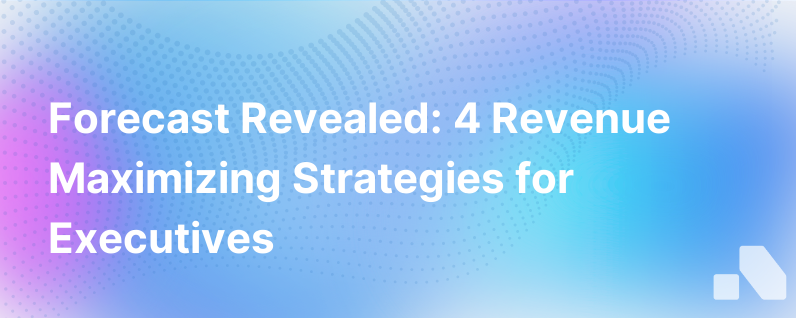The Forecast 4 Revenue Maximizing Strategies
Published on September 22, 2023 by Sawyer Middeleer
In the world of B2B sales, the ability to predict and scale revenues depends on a mix of art and science. Sales forecasting is the process of estimating future sales, and is crucial for managing and steering a business. While forecasting provides the navigational map, revenue maximization strategies are the engine propelling a business forward. Combining the accuracy of forecasting with effective revenue strategies ensures a dynamic, growth-oriented enterprise.
In this article, we will dissect ‘The Forecast 4’ – a quartet of revenue-maximizing strategies that draw from the predictive power of sales forecasts. Whether your business is striving for a robust market entry or seeking to solidify its place in a crowded market sector, these strategies will be instrumental in your company’s revenue journey.
1. Data-Driven Decision Making
The first strategy emphasizes leveraging data for enhanced decision-making. In a market inundated with information, discerning actionable insights from noise is a vital skill. With advanced analytics, businesses can now employ sales data to pinpoint trends, buyer behaviors, and potential growth areas, thereby allowing for a high degree of accuracy in sales forecasting.
Make data central to your operations. Instead of relying on intuition, base your pricing, product development, and market strategies on robust data analysis. Ensuring that this data is integrated into your CRM and accessible to teams is pivotal. Technologies like Aomni can assist in making sense of data, providing actionable insights and allowing sales teams to adapt selling strategies in real-time to maximize revenue potential.
2. Pricing Optimization
Pricing is never just a number; it's a statement of value and a direct line to competitive advantage. Therefore, the second revenue maximization strategy involves optimizing your pricing model. Sales forecasts can help identify how different price points could influence demand and revenue. Utilizing elasticities—how sensitive your customers are to price changes—is key. Evaluate price positioning continually in response to market dynamics, consumer behavior, and competitor moves.
Having a variety of pricing strategies at your disposal is an asset. Consider using tiered pricing for different levels of service, volume discounts for bulk purchases, and dynamic pricing that changes in response to supply and demand. The aim is to find that pricing sweet spot where customer perceived value meets profitability.
3. Customer Lifetime Value Enhancement
Maximizing the value a business gets from a customer over time is critical for sustainable growth. Enhancing the customer lifetime value (CLV) is the third strategy, and it begins with understanding the customer journey. Cohort analysis in your forecasting can group customers based on their behaviors and purchase patterns, allowing more personalized marketing and sales approaches.
Investing in customer relationships leads to improved retention, which is often less costly than acquiring new clients. Strategies such as implementing loyalty programs, personalized communication, upselling and cross-selling can all contribute to increasing the CLV. Moreover, using a predictive forecasting model helps in anticipating customer needs and tailoring product offerings.
4. Agile Innovation
Responding promptly to market changes requires agility, making it essential to have an innovation mindset. Forecasting is not merely about predicting sales for existing products but also serves as a guidepost for innovating new products or services. Understanding unmet needs through forecasting can illuminate where your R&D dollars should be directed to develop innovations that fulfill market gaps and create new categories of demand.
Incorporate customer feedback loops and market research into product development to ensure that new offerings are tightly aligned with customer requirements. Forecast data can help refine go-to-market strategies for these innovations, setting them up for a stronger market reception.
Why Are These Strategies Effective?
Each of these strategies is aligned with fundamental aspects of sales and revenue generation:
- Data-Driven Decision Making: Makes your sales efforts more precise and predictions more accurate.
- Pricing Optimization: Directly affects your sales volume and margin.
- Customer Lifetime Value Enhancement: Shifts focus from short-term gains to long-term relationships, which are often more lucrative.
- Agile Innovation: Ensures that your product/service offerings remain relevant and that you can capitalize on emerging opportunities.
Implementing the Forecast 4 Strategies
Analyze Your Current Position
To implement these strategies effectively, start with a robust analysis of your current position. Thoroughly review your sales data, customer feedback, market trends, and competitor activities. This will give insights into what’s working and what isn’t, and where there’s room for optimization.
Set Clear Objectives
Setting clear objectives is crucial. Specific goals are critical for implementing new strategies. Use SMART principles (Specific, Measurable, Achievable, Relevant, Time-Bound) to define your revenue targets.
Engage Cross-Functional Teams
Cross-functional involvement is essential. Sales, marketing, product development, and customer service teams should all contribute their insights. This creates a cohesive approach to maximizing revenue, where every department aligns their efforts.
Monitor, Measure, and Adapt
Finally, track your progress rigorously. Implement KPIs directly tied to your strategic objectives, and review them regularly. Adapt and evolve your approaches based on this continual feedback loop. With tools such as Aomni, which can provide real-time analytics, you can dynamically adjust your strategies and tactics to stay on the revenue-maximizing path.
Conclusion
Forecasting is more than a predictive step; it’s foundational for strategic decision-making. Mixed with the four revenue-maximizing strategies—data-driven decision-making, pricing optimization, customer lifetime value enhancement, and agile innovation—sales forecasting can serve as a powerful tool for steering a business towards revenue maximization.
Achieving revenue goals is a multifaceted endeavor that demands attention to various functions of the business, from the granularity of pricing to the broader strokes of innovation. Implementing ‘The Forecast 4’ strategies will require dedication and adaptability, but the benefits—revenue growth, market competitiveness, and financial sustainability—are more than worth the investment.